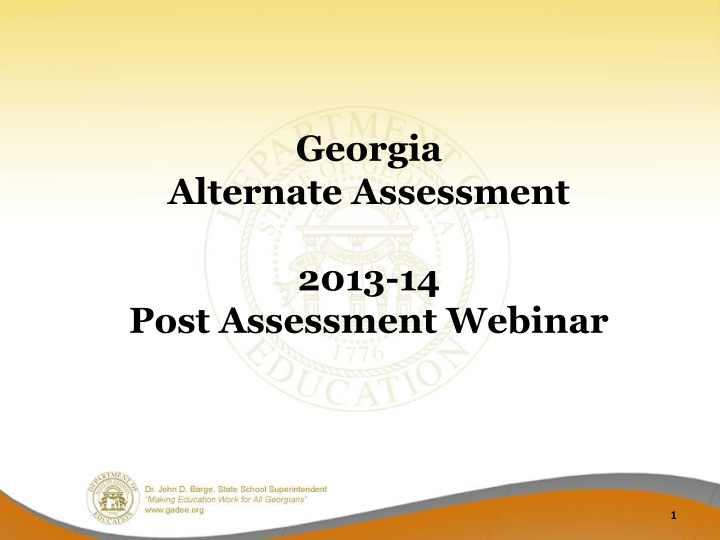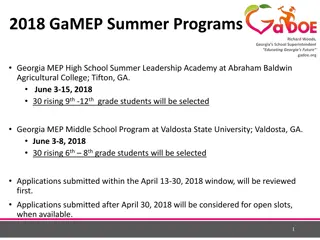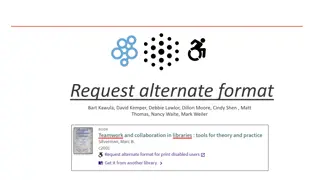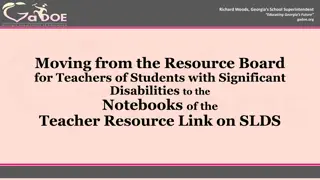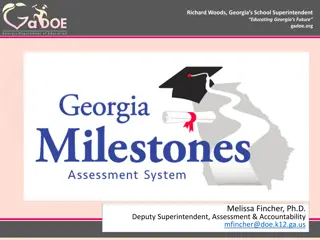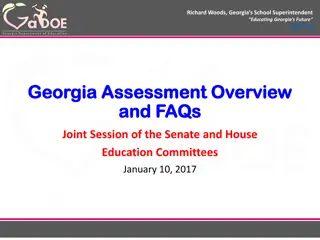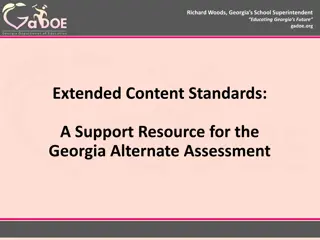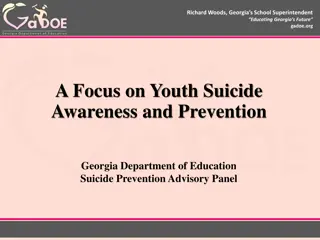Georgia Alternate Assessment (GAA) Post-Assessment Webinar Overview
Presentation overview of the Georgia Alternate Assessment (GAA) Post-Assessment Webinar focusing on interpreting reports and data related to GAA scores. Topics include GAA scoring rubric, portfolios, nonscorables, and interpreting GAA scores in conjunction with other student information.
Download Presentation

Please find below an Image/Link to download the presentation.
The content on the website is provided AS IS for your information and personal use only. It may not be sold, licensed, or shared on other websites without obtaining consent from the author.If you encounter any issues during the download, it is possible that the publisher has removed the file from their server.
You are allowed to download the files provided on this website for personal or commercial use, subject to the condition that they are used lawfully. All files are the property of their respective owners.
The content on the website is provided AS IS for your information and personal use only. It may not be sold, licensed, or shared on other websites without obtaining consent from the author.
E N D
Presentation Transcript
Georgia Alternate Assessment 2013-14 Post Assessment Webinar 1
Georgia Alternate Assessment (GAA) Post Assessment Webinar, June 11-13, 2014 Welcome! The power point presentation is available as a link on the GAA Presentations webpage at: http://www.doe.k12.ga.us/Curriculum-Instruction-and- Assessment/Assessment/Pages/GAA-Presentations.aspx Webinar Etiquette: Please use the Audio Setup Wizard in the Tools Menu to configure and test your audio settings before the presentation begins. o To eliminate interference from background noise in your area, please leave the Talk Button on mute if you are not speaking. o Due to the number of participants, we request that questions be submitted via Chat. o You will receive a prompt to download this PowerPoint. You can also go to Window, File Transfer to download any files sent through this webinar. o Please log-in with your name and the name of your district beside it (e. g., John Smith Appling). If you have already logged-in, please place your name and district in the chat box. o 2
Post Assessment Webinar The purpose of this workshop is to provide System and School personnel with information to interpret reports and data related to the Georgia Alternate Assessment (GAA). The purpose of the GAA is to ensure that students with significant cognitive disabilities are: o Provided access to the state-mandated content standards. o Given the opportunity to demonstrate progress toward achievement of content standard knowledge, concepts, and skills. 3
Topics that will be presented and discussed The Georgia Alternate Assessment The Use of Alternate Assessments and GAA Scores GAA Scoring Rubric Portfolios Submitted 2013-14 vs. 2012-13 Nonscorables How Scores Are Calculated Samples of GAA Score Reports Interpreting the GAA Scores 4
The Use of Alternate Assessments and GAA Scores The GAA serves as one indicator of student achievement and progress and should be interpreted in conjunction with other available information about the student. While the GAA is not a direct evaluation of the progress a student makes on IEP goals and objectives, IEP goals remain important and should be considered along with GAA scores. 5
Rubric Dimensions Fidelity to Standard: A dimension of the scoring rubric that assesses the degree to which the instructional activity, as demonstrated by student work, addresses the grade-level standard. Context: A dimension of the scoring rubric that assesses the degree to which the student work exhibits the use of grade-appropriate materials that reflect a purposeful and natural/real-world application. Achievement/Progress: A dimension of the scoring rubric that assesses the measurable, forward movement of a student s performance of a standards-based instructional task as documented by increased proficiency over time. Progress will be assessed from the first collection period, which will demonstrate the student s initial skill level, to the second collection period, which will demonstrate a more advanced level of skill development. Generalization: A dimension of the scoring rubric that assesses the student s opportunity to apply learned skills in other settings and with various individuals in addition to the teacher or paraprofessional. Generalization is scored once across the portfolio. 6
Possible scores for each dimension: Dimension Possible Points Fidelity to Standard Context Achievement/Progress Generalization 1-3 1-4 1-4 1-4 Fidelity to Standard, Context, and Achievement/Progress are scored for each entry. Generalization is scored once across the entire portfolio. 7
Georgia Alternate AssessmentScoring Rubric Dimension 1 2 3 The instructional activity is aligned to a content standard, all aspects of the element selected are addressed, and the student work addresses academic content at or approaching basic grade-level expectations. The instructional activity is aligned to and exposes the student to a content standard, but the student work does not address academic content. The instructional activity is aligned to a content standard; the student work addresses academic content but at an access or entry level. Fidelity to Standard (scored for each entry) 1 2 3 4 Context Materials are grade- appropriate, but the student work does not reflect a purposeful application. Materials are grade- appropriate, and the student work reflects a purposeful simulated application. Materials are grade- appropriate, and the student work reflects a purposeful natural/real- world application. (scored for each entry) Materials are not grade- appropriate. Achievement/ Progress (scored for each entry) Student demonstrates little achievement/progress in targeted instructional activity. Student demonstrates some achievement/progress in targeted instructional activity. Student demonstrates reasonable achievement/progress in targeted instructional activity. Student demonstrates exceptional achievement/progress in targeted instructional activity. Student performs tasks in one or more settings with evidence of interaction (s) with other instructional providers and/or disabled classmates. Generalization (scored once across all entries in portfolio) Student performs tasks in one or more settings with no evidence of interaction(s) beyond those with the primary instructional provider. Student performs tasks in two different settings with evidence of interaction(s) with non-disabled peers and/or community members. Student performs tasks in three or more different settings with evidence of interaction(s) with non- disabled peers and/or community members. 8
GAA Portfolios Submitted 2013-2014 Portfolios Submitted 145 1387 1401 1536 1527 1587 1716 2012-2013 Portfolios Submitted 171 1286 1398 1417 1546 1482 1590 2013-2014 Total Entries 2012-2013 Total Entries Grade K 3 4 5 6 7 8 580 8322 8406 9216 9162 9522 10296 684 7716 8388 8502 9276 8892 9540 High School 1364 1388 10912 11104 10663 10278 66416 64102 10,663 portfolios were submitted in 2013-2014 compared to 10,278 submitted in 2012-2013. This table provides a breakdown, by grade, including the total number of entries for both 2013-2014 and 2012-2013. 298 High School Retest portfolios were submitted in Spring 2014. 9
What We Found In general, the portfolios were complete and well executed. The portfolios provided valuable information as to areas of focus for upcoming training. Training will continue to focus on alignment, documentation, and evidence requirements. Across all grades and content areas, the vast majority of students met or exceeded expectations as demonstrated by their Performance Level Indicator. Number and percent of nonscorables continues to be low. 10
Frequency of Nonscorables The majority of Nonscorables received a code of Not Aligned (NA). The vast majority of these were because one or more of the instructional tasks (not all) were not aligned to the content standard and/or indicator and thus received the code of NA. The next highest number of nonscorable entries received the code of Insufficient Evidence (IE). A significant decrease was also found in this category from the previous administrations. 11
Grade 7 Math Increase in percentage of students in Emerging Progress. Some of this increase is related to a higher frequency of non-scorables in Grade 7 Math. Contributing factors may include: o MCC.7.G.1 (solve problems involving scale drawings of geometric figures), non-geometric figures were accepted; however o MCC.7.G.2 (describe the two-dimensional figures ), three-dimensional figures were not accepted. The apparent need for clarity relative to the standards has been noted for our August 2014 fall trainings. 12
Nonscorable Codes Chart Should a student receive a Nonscorable Code for an entry, the code and it s definition will be provided on side 2 of the Individual Student Report. The Nonscorable Codes and Definitionsare also provided in the following places: On side 2 of the Student Roster Page 13 of the Score Interpretation Guide 13
Frequency of Nonscorables by Number and Percent 2013-14 First Time Test Takers NS Code Frequency Percent of NS Percent of all entries ME 140 1.77% 0.21% ES 103 1.30% 0.16% NA 6471 81.75% 9.74% IE 1061 13.40% 1.60% IT 77 0.97% 0.12% OG 20 0.25% 0.03% IS 44 0.56% 0.06% Total 7916 100.0% 11.92% 7,916 of 66,416 entries received NS codes 14
How Scores are Calculated Kindergarten Each portfolio consisted of four entries: two ELA / two Mathematics Grades 3-8 Each portfolio consisted of six entries: two ELA / two Mathematics / one Science / one Social Studies Each entry was scored for each of the three rubric dimensions: Fidelity to Standard, Context, and Achievement/Progress The fourth rubric dimension, Generalization, Scored once across the scorable entries for the entire portfolio 15
How Scores are Calculated High School Each portfolio consisted of eight entries: two ELA/ two Mathematics / two Science / two Social Studies Each entry is scored by two independent readers Each entry was scored for each of the three rubric dimensions: Fidelity to Standard, Context, and Achievement/Progress The fourth rubric dimension, Generalization, Scored once across the scorable entries for the entire portfolio 16
Score Calculation for Kindergarten and 3-8 Fidelity to Standard, Context, Achievement/Progress A total score for each dimension within each content area is calculated as the average of the two entry scores rounded to the nearest whole point. If one entry is nonscorable, that entry is treated as having a score of zero for the purpose of calculating the average. Dimension Score= Entry 1 Score + Entry 2 Score (rounded) 2 Score calculations for Mathematics, Science, and Social Studies are the same as the ELA examples on the following slides. 17
Score Calculation for Kindergarten and 3-8 Fidelity to Standard, Context, Achievement/Progress Examples: Rubric Dimension: ELA Entry 1 score: ELA Entry 2 score: Total score = (2 + 3) / 2 = 2.5 2.5 rounds to 3 Fidelity to Standard 2 3 Rubric Dimension: ELA Entry 1 Score: 1 ELA Entry 2 score: 1 Total score = Total Context Dimension score = 1 Context (1 + 1) / 2 = 1 Total Fidelity to StandardDimension score = 3 Rubric Dimension: ELA Entry 1 Score: ELA Entry 2 Score: Total Score = Achievement/Progress 4 4 (4 + 4) / 2 = 4 Total Achievement/Progress Dimension score = 4 18
Score Calculation for Kindergarten and 3-8 Generalization (is scored once across all scorable entries) Dimension score = Generalization score The Generalization score assesses a student s opportunity for interaction with others, as well as the diversity of settings across all content areas and entries in the portfolio. Finally, the scores for each of the dimensions are not combined to form a single numeric score, but are reported separately. Example: Student s ELAScoresStudent s byDimension ELA Score Fidelity: 3 Context: 1 Achievement/Progress: 4 Generalization: 2 3142 19
Score Calculation for High School Fidelity to Standard, Context, Achievement/Progress For High School, two independent readers score each entry of the student s portfolio in the three rubric dimensions of Fidelity to Standard, Context, and Achievement/Progress. Each reader scores Generalization once across the entire portfolio. The entry score is determined by averaging the scores from reader one and reader two. Note: For each content area requiring a retest, both entries for the content area must be submitted. Entry Score = Reader 1 Score + Reader 2 Score (unrounded) 2 20
Score Calculation for High School Fidelity to Standard, Context, Achievement/Progress Entry Score = Reader 1 Score + Reader 2 Score (unrounded) 2 Example: Rubric Dimension: Reader 1 ELA Entry 1 score: Reader 2 ELA Entry 1 score: ELA Entry 1 Score = (3 + 2) / 2 = 2.5 Reader 1 ELA Entry 2 score: Reader 2 ELA Entry 2 score: ELA Entry 2 Score = (3 + 3) / 2 = 3 Fidelity to Standard 3 2 3 3 21
Score Calculation for High School Fidelity to Standard, Context, Achievement/Progress After the entry scores are determined for each content area,a total score for each dimension within each content area is calculated as the average of the entry scores rounded to the nearest whole point. If one entry is nonscorable, that entry is treated as having a score of zero for the purpose of calculating the average. Dimension Score = Entry 1 Score + Entry 2 Score (rounded) 2 Score calculations for Mathematics, Science, and Social Studies are the same as the ELA examples on the following slides. 22
Score Calculation for High School Fidelity to Standard, Context, Achievement/Progress Examples: Rubric Dimension: ELA Entry 1 score: ELA Entry 2 score: Total score = (2.5 + 3) / 2 = 2.75 2.75 rounds to 3 Fidelity to Standard 2.5 3 Rubric Dimension: ELA Entry 1 Score: 1 ELA Entry 2 score: 1 Total score = Total Context Dimension score = 1 Context (1 + 1) / 2 = 1 Total Fidelity to Standard Dimension score = 3 Rubric Dimension: ELA Entry 1 Score: ELA Entry 2 Score: Total Score = Total Achievement/Progress Dimension score = 3 Achievement/Progress 2 3 (2 + 3) / 2 = 2.5 2.5 rounds to 3 23
Score Calculation for High School Generalization(scored once across all scorable entries) Dimension score = Generalization score The Generalization score assesses a student s opportunity for interaction with others, as well as the diversity of settings across all content areas and entries in the portfolio. Finally, the scores for each of the dimensions are not combined to form a single numeric score, but are reported separately. Example: Student s ELAScoresStudent s byDimension ELA Score Fidelity: 3 Context: 1 Achievement/Progress: 3 Generalization: 2 3132 24
GAA Score Reports GAA score reports provide information on the Stage of Progress achieved by each student in each content area, as well as the assigned score for each rubric dimension. 25
Electronic Data Files A data file format document is included in each system data file package. This file is the key to the system data file including what data is included in the various columns. Please note some key column headings: 1) SSPELA - BT 2) SSPMath - BU 3) SSPSCI - BV 4) SSPSS - BW E1 = Emerging Progress; E2 = Established Progress; E3 = Extending Progress For more information, refer to the Score Interpretation Guide, 2013-2014 page 31. 26
School and System Report Shipments Reports are provided at the student, school, and system levels. The system report shipment contains: The school report shipment contains: System Summary Overall Summary of Performance System Summary By Grade System Performance By Strand School Summary of Student Performance Roster School Summary of Student Performance Profile Individual Student Reports (ISRs) Individual Student Labels School Summary of Student Performance Roster School Summary of Student Performance Profile 27
Secure Summary Reports Due to the small numbers of students participating in the GAA, all summary reports are marked as secure. Any report that identifies an individual student is a secure report and must be treated in a way to protect the privacy of the student. The following statement appears on each Summary report: Secure Report Not for public distribution due to limited number of students; caution should be used when interpreting summary data. 28
Individual Student Reports The Student Score Report is designed for parents and provides feedback on how the student performed on the GAA. 29
Kindergarten, 3-8 Individual Student Report Individual Student Report Side 1 Individual Student Report Side 2 30
Individual Student Report Side One: Scores for each content area assessed by dimension Fidelity to Standard Context Achievement/Progress Description of the student's Stage of Progress (performance level) Extending Progress Established Progress Emerging Progress 31
Individual Student Report Side One: The dimension score earned for Generalization 32
Individual Student Report Side Two: Definitions of the four scoring dimensions 33
Individual Student Report Side Two: The total possible points and the actual points the student earned for each entry The strand assessed for the entry 34
Individual Student Report Side Two: Any Nonscorable codes issued for the student entries are listed and defined Student s Generalization score 35
High School Individual Student Report Individual Student Report Side 1 Individual Student Report Side 2 36
High School Individual Student Report Side Two: Science and Social Studies have 2 entries 37
Individual Student Labels The Individual Student Label presents summary information similar to that contained on the Student Score Report but on a small label appropriate for use in a student s permanent record folder. 38
Grade 3 Example Individual Student Labels Kindergarten Example 39
School Reports The School Summary of Student Performance, organized by grade, is made up of two parts: School Summary of Student Performance Roster School Summary of Student Performance Profile 40
School Summary of Student PerformanceRoster Each student in that grade who participated in the GAA is listed Student s Stage of Progress by content area Strand assessed for each entry Student s dimension scores or nonscorable code by entry and total dimension scores by content area Student s generalization score 42
School Summary of Student PerformanceRoster Average scores are summarized at the bottom of side one for each content area. Average entry scores for each dimension Average generalization score 43
School Summary of Student PerformanceRoster Student Roster side 2: provides a Strand Abbreviation Key and the Nonscorable Codes and Definitions 44
School Summary of Student PerformanceProfile The Profile is organized by grade and presents summary data for the school on two sides. Profile side 1: Number and percent of students at each Stage of Progress by content area Percent of students at each Stage of Progress in bar-graph format Student performance by rubric dimension data 46
School Summary of Student PerformanceProfile Profile side 2: Student Performance by Population Group for School N-counts Percent at each Stage of Progress Detail for Portfolios and Entries Not Scored Not Complete Portfolios Invalidations Nonscorable Assessments and breakdown by Nonscorable Code 47
System Reports The System Summary Report is made up of two parts: Overall Summary of Performance System Summary by Grade Data are presented for all students tested in the system and are also broken down by grade. Caution must be taken when interpreting summary data. 48
System Report Overall Summary of Performance Overall Summary of Performance lists system- wide performance of students taking the GAA by content area. 49
